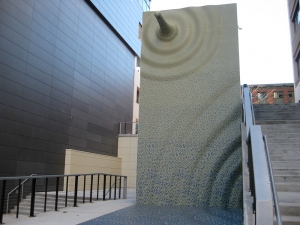
Last night, the dedication ceremony of Projecting Drop, a new public artwork at 1250 Pacific Ave., marked two important firsts: The monolithic installation is the first U.S. commission for Vancouver, B.C. artist Jill Anholt. And it is the crown jewel for Pacific Plaza, the first building in the Tacoma/Pierce County region to receive LEED (Leadership in Energy and Environmental Design) Platinum certification by the U.S. Green Building Council.
Hurrying along Pacific Plaza’s sleek glass front ablaze with holiday lights, it was hard to remember that just a few short years ago, it was a crumbling, four-story parking garage, and not a state-of-the-art office building recognized for its integrated, environmental technologies (the renovated structure is one of only 21 core-and-shell buildings worldwide to receive LEED-Platinum certification, according to a press release from BLRB Architects, designers of Pacific Plaza).
Projecting Drop is a 25′-tall artwork occupying a niche between Pacific Plaza and the newly reconstructed 12th Street hill climb connecting Pacific Avenue and Commerce Street. The soaring wall is covered in 1″ hexagonal, blue and green tiles that cascade from top to base, then ripple outward toward the street. Embedded in the sidewalk tilework is a quote from an 1891 edition of the Tacoma Ledger : “From amidst a sombre forest of firs a city has arisen as by a stroke of an enchanter’s wand. Tacoma looks forth like a new Venice over the glassy waters and prepares to handle the commerce of the world.”
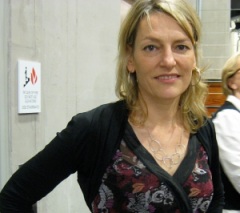
In the airy screening room of PCS Structural Solutions, on Pacific Plaza’s seventh floor, Mayor Strickland lauded Anholt’s stunning art piece, noting that it is “rooted in our past and optimistic about our future.” Ben Ferguson, an associate of BLRB Architects, said Anholt was selected from among project applicants for her “thoughtful nature and professionalism” as much as her use of “very dynamic forms with modern characteristics.”
Anholt, whose art background includes a master’s degree in architecture, and whose installations can be seen across Canada, offered a fascinating slideshow explaining how the project came into being. She said that Projecting Drop synthesizes several layers of site-specific information: geological, historical, environmental and social. The piece’s intent is to “reveal collective meaning in a poetic and not didactic way.” After hours spent sifting the archives with librarian Brian Kamers at the Tacoma Public Library, she said finding a connection between Tacoma’s past and present “renaissances” became an important theme. Aesthetically, she wanted the piece to create a “pause” wherein pedestrians could stop, notice and interact with the art. The towering wall, with its projecting raindrop that radiates out from the vertical surface, accomplishes the latter ingeniously: When pedestrians walk by in the evening, a projection activated by motion sensors flashes onto it: “Let Energy! Ambition! and Enterprise! continue to give lustre to the City of Destiny.” The quote appears like an unexpected spattering of gold while also revealing the origins of our famous moniker, the City of Destiny.
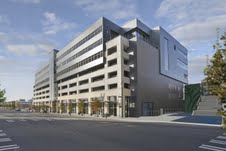
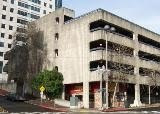
The larger story of Projecting Drop lies underground, beneath the hill climb, where a century-old Turkish bath was discovered. Once the haunt of underworld kingpins and prostitutes, the bathhouse has been re-purposed as a water cistern that irrigates the building’s green roof above, making the two hidden systems interdependent. It provided Anholt with a vital historical link between old culture and new – and supported Pacific Plaza’s aspirations as a LEED-Platinum building (the cistern also supplies the building’s nonpotable water needs, such as toilets).
“The Turkish bathhouse was mentioned briefly in the [call-to-artists], but it wasn’t until I was allowed to crawl down into the space below the plaza and discovered these two rooms covered with this beautiful tilework during our artist orientation visit, that I became completely intrigued about the history of the bath, and also that of the city of Tacoma. It is a truly remarkable city with a very colorful past!” said Anholt in an e-mail exchange. “I had no idea how I was going to weave these two times and two distinct stories together, but I did know that I wanted to do that in some way.”
It was “an incredibly progressive move” of the Pacific Plaza design team to re-purpose the 19th-century baths into a rooftop irrigation system, she said. “This incredible story, however, is completely invisible to the public. Water is the element that ties the unique past of this site to its present, and also its future….I decided to ‘bring the water to the surface’ in a very direct and simple way as an attempt to weave together storytelling and experience.” Projecting Drop‘s skin of hand-placed, hexagonal tiles echoes the surfaces of the subterranean bathhouse.
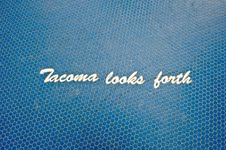
Projecting Drop was funded through a public-private partnership between the City of Tacoma and Pacific Plaza Development, LLC. The development team for the $42 million Pacific Plaza renovation project is BLRB Architects, PCS Structural Solutions, Absher Construction and the City of Tacoma. The presence of the structural engineer, the architect and the contractor as tenants in the building paved the way for construction of the artwork, said Anholt. “This project, top to bottom, was fantastic” for Tacoma, beamed BLRB’s Ben Ferguson. It gave an obsolete structure new life “and something more.”